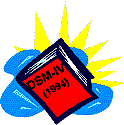By Ellen Kuwana
Neuroscience for Kids Staff Writer
June 1, 2000
Attention deficit hyperactivity disorder (ADHD)
affects an estimated 1.5-3.5 million children in the US alone.
 The main
symptoms of ADHD are inattention, hyperactivity, and inability to control
impulses. Because ADHD is the most common childhood neurobehavioral
disorder, it is of particular concern for pediatricians. The American Academy of Pediatrics (AAP) published a
set of guidelines in the May 2000 issue of Pediatrics to assist
doctors in identifying the disorder in children ages 6-12 years.
Because diagnosing ADHD in children younger than 6 years of age is
difficult, the guidelines only apply to school-aged children.
The main
symptoms of ADHD are inattention, hyperactivity, and inability to control
impulses. Because ADHD is the most common childhood neurobehavioral
disorder, it is of particular concern for pediatricians. The American Academy of Pediatrics (AAP) published a
set of guidelines in the May 2000 issue of Pediatrics to assist
doctors in identifying the disorder in children ages 6-12 years.
Because diagnosing ADHD in children younger than 6 years of age is
difficult, the guidelines only apply to school-aged children.
 The guidelines are the result of work by experts in medicine,
mental health, and education. They analyzed thousands of studies on ADHD
and searched for common indicators of the disorder. Although the
Diagnostic and Statistical Manual-IV (DSM-IV), published by the
American Psychiatric Association, lists ADHD among its disorders, the new
guidelines from the AAP are designed to be user-friendly for primary care
providers (physicians who do not specialize in mental disorders). The guidelines are the result of work by experts in medicine,
mental health, and education. They analyzed thousands of studies on ADHD
and searched for common indicators of the disorder. Although the
Diagnostic and Statistical Manual-IV (DSM-IV), published by the
American Psychiatric Association, lists ADHD among its disorders, the new
guidelines from the AAP are designed to be user-friendly for primary care
providers (physicians who do not specialize in mental disorders).
The guidelines, in brief, include:
- A primary care provider (a pediatrician, for example) should
evaluate a child who is having school or behavioral problems. These
include difficulties with teachers, family, or peers.
- The criteria in the DSM-IV for frequency of symptoms and the
settings where they occur should be followed. These criteria are that the
symptoms have a negative impact on the child's academic performance or
social interactions for at least six months, and that the symptoms be
present in at least two places, such as school and home.
- Information about the symptoms should be obtained directly from the
child's parent/guardian/caregiver, teacher, or school administrator.
This information should include how long the symptoms last, in what
settings they occur, and how much they affect the child's day-to-day
functioning.
- Co-existing conditions, such as language and learning problems,
aggression, anxiety or depression should be determined. In as many as
one-third of the children diagnosed with ADHD, these other conditions also
occur, complicating the plan for treatment and management of the
symptoms.
The goal of the new guidelines is to help physicians make an early and
accurate diagnosis of ADHD, so children get treatment and support at
school and home. Next, the American Academy of Pediatrics plans to
compose guidelines for the treatment of ADHD. |




![[email]](./gif/menue.gif)
![[survey]](./gif/menusur.gif)
![[newsletter]](./gif/menunew.gif)
![[search]](./gif/menusea.gif)
![[notes]](./gif/menunot.gif)